How to Get Rid of Static on Blankets in 10 Ways
Author: Anne Cowart | Editor: Omar Alonso
Review & Research: Jen Worst & Chris Miller

Have you ever shocked yourself with a crackling spark of static electricity? We all played those games as kids where we rubbed or socked feet on the carpet and touched our sibling or friend on the ear to see them jump in surprise at the shocking experience. But as an adult, we want to know how to get rid of static on blankets.
While it was fun as kids, it's not something we enjoy as adults. Getting into bed and turning out the lights to see the blanket light up like a fireworks display with static electricity isn't fun; it's annoying. The static makes the blanket cling to your skin uncomfortably, and there's always the chance of that unpleasant shock. It's not exactly what we want before we drift off to sleep, right?
How to Get Static Out of a Blanket in 10 Ways
So, how can you avoid that annoying static shock when untangling blankets or jumping into bed? This post gives you a few strategies to make static shock a thing of the past.
1) Avoid Wool Blankets
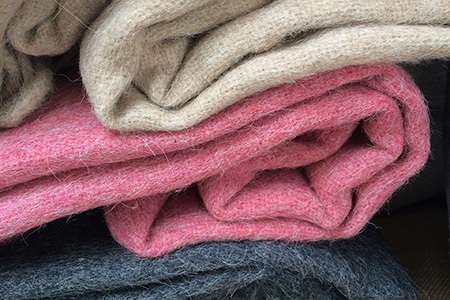
Of all the types of blankets, wool blankets are the worst when it comes to static electricity. When most of us think about electricity, we think about the energy powering our household appliances, not the energy found in clothing and blankets. However, you might not realize that we all have a small amount of electricity energized on our skin.
We can generate static electricity by rubbing charged objects on our skin. Wool and glass are examples of materials generating a static charge. You'll also create it with your skin and hair. You've probably noticed that static can make your hair stand on end when positively charged.
The best example of static accumulating on our skin is what we discussed earlier. Wear a pair of wool socks and drag your feet over a carpet. The static charge runs across our skin and releases when we touch something.
This transfer of electrons from the carpet to our socks distributes through our body, resulting in a static shock when we touch someone else. It's somewhat amusing, especially when the other person doesn't expect it.
Static can also build up similarly on your sheets, depending on what bedding you use at home. As a result, you might climb into bed to a shocking surprise. Or once you know how to store blankets, the worst is pulling them out and having them shock you over and over. So, how do you stop this from happening? Here are a few tips to help you avoid static.
2) Use a Damp Towel or Aluminum in the Drying Cycle
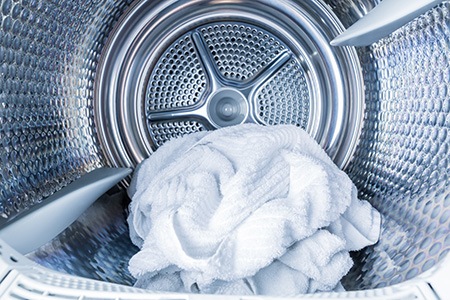
Drying your bed sheet types and blankets in the dryer cuts down on the drying time, but it also has the potential to add static. If you want to keep using the dryer and avoid static buildup, add a damp hand towel to the dryer cabinet in the last 20 minutes of the cycle.
Another hack to limit static from the dryer is to add a ball of aluminum foil to the dryer cabinet in the last 20 minutes of the cycle. The aluminum disperses the static charge, leaving you with static-free bedding. How to get rid of static on blankets? Don't let it accumulate in the first place.
3) Wash with Baking Soda
Why use expensive detergents when washing your clothes when you can get outstanding results from common household products. Adding baking soda to your wash makes the whites whiter and the colors brighter.
It also helps to reduce the buildup of static charge during the drying cycle or when drying your clothing and bedding indoors. Baking soda removes unpleasant odors from the washing machine and your clothes and makes the bedding resistant to static accumulation.
You can use baking soda and white vinegar in the same wash cycle, giving you a dual washing action that deodorizes and cleans while lifting tough stains. That brings us to our next hack for removing static in a blanket.
4) Rinse with White Vinegar
Rinse the wash with white vinegar. This common household item is great for flavoring food and has many cleaning applications around the home. Add white vinegar to your wash cycle, and you'll remove stains from your bedding, leaving it fresh and clean while reducing static charge in the fabrics.
Don't add vinegar to the wash cycle alongside bleach. This combination causes the formation of chlorine gas which is lethal if you breathe it in. Add around half a cup of white vinegar to the wash, and you'll notice the difference.
5) Select the Right Dryer Sheets
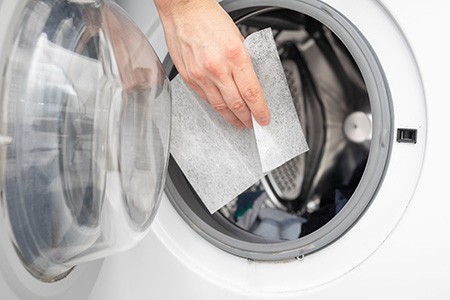
Some dryer sheets are better at removing static than others. Several manufacturers offer specialized dryer sheets advertised to remove the static cling from your clothing, bedding, and blankets.
Add dryer sheets to your laundry cycle, and you'll never have to worry about static accumulation again. Dryer sheets remove static, leaving your laundry smelling clean and fresh and feeling super-soft. There are dryer sheet alternatives you can try as well.
6) Hang the Laundry Outdoors
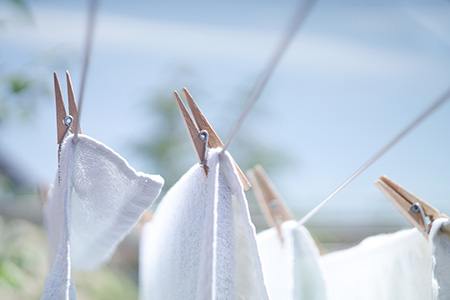
One of the best tips for eliminating static cling from bedding and blankets is to hang your laundry outdoors on a line instead of drying it in the dryer. If you live in a warm climate like Florida or Texas, hang your laundry outside when the weather permits. You'll notice a dramatic reduction in the amount of static accumulating in your bedding and blankets.
Hanging your laundry outdoors removes the static and accentuates the scent of your fabric softener and detergent, leaving your laundry smelling fresh and feeling soft. The sun's powerful UV rays also kill any bacteria and viruses left on the bedding and blankets. This is how to get rid of static on blankets while getting a deeper clean.
As a pro tip – ensure you turn your clothing inside-out when drying it on the line outdoors. This strategy prevents the sun from prematurely fading the color of your clothes. Your shirts and pants will last longer.
7) Choose Blankets With the Right Materials
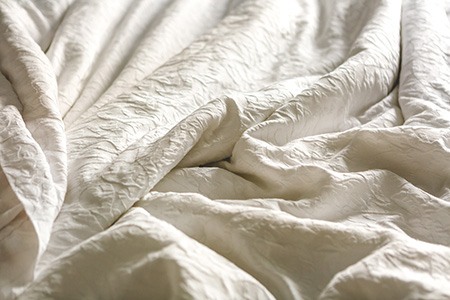
Choosing the right materials is the best strategy for preventing static buildup in your blankets and bedding. Wool is the worst material for your bedding as it readily conducts static. Many other materials do a much better job at naturally dispelling static from your blankets and bedding.
Synthetic fabrics like acetate, nylon, rayon, and polyester are notorious for creating static cling, so avoid them when selecting your preferred types of bed covers if you can. You won't need to know how to get rid of static electricity on blankets if you minimize it far enough in the first place.
These fabrics will generate static electricity from being in the dryer (and be careful because while it's less rare with synthetics, fabrics like nylon may shrink in the dryer).
It's a better idea to go for traditional fabrics like cotton. Neutral fabrics like silk are also great at avoiding static cling, so choose those for your bedding and beat the static. If you use neutral materials, you don't have to worry about taking steps to remove the static.
8) Apply Lotion Before Bed
As you learned in the example involving adding a damp towel to the dryer, moisture plays a key role in removing static from bedding and blankets. So, if you don't use moisture in the drying process, you can always use it on your skin to remove static cling and buildup.
Apply moisturizing lotion to your body in the morning and before bed. If you have long hair, try moisturizing your hands and running your fingers through your hair before you go to bed to reduce the propensity for static cling and shock on your bedding.
You can also run your hairbrush under the tap before brushing your hair if you want to avoid feeling greasy from the moisturizer. This approach doesn't make your hair wet, and you don't have to worry about getting it frizzy. It adds just the right amount of moisture to prevent static accumulation.
9) Run a Humidifier in the Bedroom
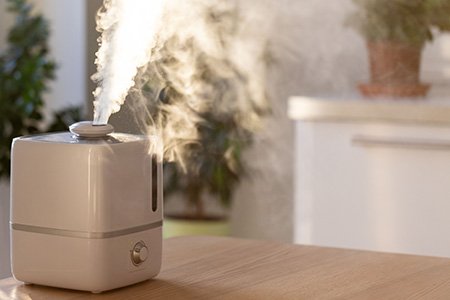
Another option for how to get rid of static on blankets is to moisturize the air in your bedroom. Run a humidifier to increase the relative humidity in the room before you go to bed. The humidifier turns water into water vapor, using a fan to circulate it around the room.
If you don't have a humidifier, you can buy a small water feature for your bedroom and leave it running next to your bed on your bedside table. It doesn't need to be a large water feature. A small one will do the job and reduce the potential of static accumulation in your sheets and blankets. There are other humidifier alternatives to look into as well.
It's a great option for those people living in dry climates like Arizona. Increasing the relative humidity in the room is a great way to eliminate static. However, it won't work in states like Florida, where there's already a high relative humidity level in the air.
10) Use Wire Hangers & Washcloths to Discharge the Bedding
If you find you always get a shock when climbing into bed, you can remove the static charge from your blankets and sheets by running a metal wire hanger over them before climbing under the covers. Run the wire hanger over the top of the blanket, and it neutralizes the electrical charge.
The fabric softener used in washing your sheets works in the dryer to neutralize static cling and accumulation, and the wire hanger discharges static buildup before getting into the bed. You can also take the approach of wetting a washcloth and wringing it out, then running it across the bedding before you get under the covers. This hack reduces static cling significantly.
That’s How to Get Rid of Static on Blankets
No one wants a shocking experience when they go to bed. Getting a bunch of sparks lighting up the bedroom before you hit the hay isn't conducive to calming your down. It's an annoyance you need to nip in the bud. Implement these tips to learn how to get rid of static on blankets and set yourself up for a peaceful night, free from sparks and static.




